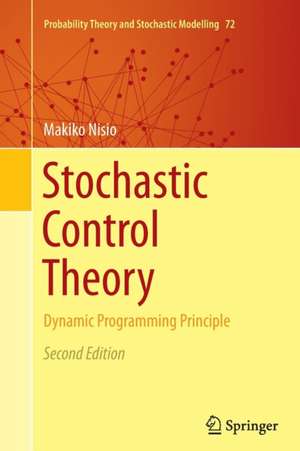Stochastic Control Theory: Dynamic Programming Principle: Probability Theory and Stochastic Modelling, cartea 72
Autor Makiko Nisioen Limba Engleză Paperback – 23 aug 2016
First we consider completely observable control problems with finite horizons. Using a time discretization we construct a nonlinear semigroup related to the dynamic programming principle (DPP), whose generator provides the Hamilton–Jacobi–Bellman (HJB) equation, and we characterize the value function via the nonlinear semigroup, besides the viscosity solution theory. When we control not only the dynamics of a system but also the terminal time of its evolution, control-stopping problems arise. This problem is treated in the same frameworks, via the nonlinear semigroup. Its results are applicable to the American option price problem.
Zero-sum two-player time-homogeneous stochastic differential games and viscosity solutions of the Isaacs equations arising from such games are studied via a nonlinear semigroup related to DPP (the min-max principle, to be precise). Using semi-discretization arguments, we construct the nonlinear semigroups whose generators provide lower and upper Isaacs equations.
Concerning partially observable control problems, we refer to stochastic parabolic equations driven by colored Wiener noises, in particular, the Zakai equation. The existence and uniqueness of solutions and regularities as well as Itô's formula are stated. A control problem for the Zakai equations has a nonlinear semigroup whose generator provides the HJB equation on a Banach space. The value function turns out to be a unique viscosity solution for the HJB equation under mild conditions.
This edition provides a more generalized treatment of the topic than does the earlier book Lectures on Stochastic Control Theory (ISI Lecture Notes 9), where time-homogeneous cases are dealt with. Here, for finite time-horizon control problems, DPP was formulated as aone-parameter nonlinear semigroup, whose generator provides the HJB equation, by using a time-discretization method. The semigroup corresponds to the value function and is characterized as the envelope of Markovian transition semigroups of responses for constant control processes. Besides finite time-horizon controls, the book discusses control-stopping problems in the same frameworks.
| Toate formatele și edițiile | Preț | Express |
|---|---|---|
| Paperback (1) | 909.33 lei 6-8 săpt. | |
| Springer – 23 aug 2016 | 909.33 lei 6-8 săpt. | |
| Hardback (1) | 736.09 lei 3-5 săpt. | +193.98 lei 6-10 zile |
| Springer – 9 dec 2014 | 736.09 lei 3-5 săpt. | +193.98 lei 6-10 zile |
Din seria Probability Theory and Stochastic Modelling
- 18%
 Preț: 1261.46 lei
Preț: 1261.46 lei - 18%
 Preț: 736.09 lei
Preț: 736.09 lei - 15%
 Preț: 675.58 lei
Preț: 675.58 lei - 24%
 Preț: 769.43 lei
Preț: 769.43 lei - 17%
 Preț: 372.95 lei
Preț: 372.95 lei - 18%
 Preț: 779.89 lei
Preț: 779.89 lei - 18%
 Preț: 1019.97 lei
Preț: 1019.97 lei - 18%
 Preț: 888.01 lei
Preț: 888.01 lei - 18%
 Preț: 905.54 lei
Preț: 905.54 lei - 18%
 Preț: 958.07 lei
Preț: 958.07 lei - 18%
 Preț: 902.55 lei
Preț: 902.55 lei - 15%
 Preț: 641.71 lei
Preț: 641.71 lei - 15%
 Preț: 502.87 lei
Preț: 502.87 lei - 15%
 Preț: 940.86 lei
Preț: 940.86 lei - 15%
 Preț: 733.24 lei
Preț: 733.24 lei - 15%
 Preț: 587.39 lei
Preț: 587.39 lei - 15%
 Preț: 708.28 lei
Preț: 708.28 lei - 18%
 Preț: 789.52 lei
Preț: 789.52 lei - 18%
 Preț: 1024.85 lei
Preț: 1024.85 lei - 23%
 Preț: 1199.04 lei
Preț: 1199.04 lei - 18%
 Preț: 977.54 lei
Preț: 977.54 lei - 18%
 Preț: 872.77 lei
Preț: 872.77 lei - 18%
 Preț: 1892.55 lei
Preț: 1892.55 lei - 18%
 Preț: 1025.47 lei
Preț: 1025.47 lei - 18%
 Preț: 856.72 lei
Preț: 856.72 lei - 18%
 Preț: 894.79 lei
Preț: 894.79 lei - 15%
 Preț: 595.54 lei
Preț: 595.54 lei - 24%
 Preț: 966.81 lei
Preț: 966.81 lei - 18%
 Preț: 793.63 lei
Preț: 793.63 lei - 18%
 Preț: 736.11 lei
Preț: 736.11 lei
Preț: 909.33 lei
Preț vechi: 1108.95 lei
-18% Nou
Puncte Express: 1364
Preț estimativ în valută:
173.100€ • 189.60$ • 146.62£
173.100€ • 189.60$ • 146.62£
Carte tipărită la comandă
Livrare economică 23 aprilie-07 mai
Preluare comenzi: 021 569.72.76
Specificații
ISBN-13: 9784431564089
ISBN-10: 443156408X
Pagini: 265
Ilustrații: XV, 250 p.
Dimensiuni: 155 x 235 x 14 mm
Greutate: 4.1 kg
Ediția:Softcover reprint of the original 2nd ed. 2015
Editura: Springer
Colecția Springer
Seria Probability Theory and Stochastic Modelling
Locul publicării:Tokyo, Japan
ISBN-10: 443156408X
Pagini: 265
Ilustrații: XV, 250 p.
Dimensiuni: 155 x 235 x 14 mm
Greutate: 4.1 kg
Ediția:Softcover reprint of the original 2nd ed. 2015
Editura: Springer
Colecția Springer
Seria Probability Theory and Stochastic Modelling
Locul publicării:Tokyo, Japan
Textul de pe ultima copertă
This book offers a systematic introduction to the optimal stochastic control theory via the dynamic programming principle, which is a powerful tool to analyze control problems.
First we consider completely observable control problems with finite horizons. Using a time discretization we construct a nonlinear semigroup related to the dynamic programming principle (DPP), whose generator provides the Hamilton–Jacobi–Bellman (HJB) equation, and we characterize the value function via the nonlinear semigroup, besides the viscosity solution theory. When we control not only the dynamics of a system but also the terminal time of its evolution, control-stopping problems arise. This problem is treated in the same frameworks, via the nonlinear semigroup. Its results are applicable to the American option price problem.
Zero-sum two-player time-homogeneous stochastic differential games and viscosity solutions of the Isaacs equations arising from such games are studied via a nonlinear semigroup related to DPP (the min-max principle, to be precise). Using semi-discretization arguments, we construct the nonlinear semigroups whose generators provide lower and upper Isaacs equations.
Concerning partially observable control problems, we refer to stochastic parabolic equations driven by colored Wiener noises, in particular, the Zakai equation. The existence and uniqueness of solutions and regularities as well as Itô's formula are stated. A control problem for the Zakai equations has a nonlinear semigroup whose generator provides the HJB equation on a Banach space. The value function turns out to be a unique viscosity solution for the HJB equation under mild conditions.
This edition provides a more generalized treatment of the topic than does the earlier book Lectures on Stochastic Control Theory (ISI Lecture Notes 9), where time-homogeneous cases are dealt with. Here, for finite time-horizon control problems, DPP was formulated as aone-parameter nonlinear semigroup, whose generator provides the HJB equation, by using a time-discretization method. The semigroup corresponds to the value function and is characterized as the envelope of Markovian transition semigroups of responses for constant control processes. Besides finite time-horizon controls, the book discusses control-stopping problems in the same frameworks.
First we consider completely observable control problems with finite horizons. Using a time discretization we construct a nonlinear semigroup related to the dynamic programming principle (DPP), whose generator provides the Hamilton–Jacobi–Bellman (HJB) equation, and we characterize the value function via the nonlinear semigroup, besides the viscosity solution theory. When we control not only the dynamics of a system but also the terminal time of its evolution, control-stopping problems arise. This problem is treated in the same frameworks, via the nonlinear semigroup. Its results are applicable to the American option price problem.
Zero-sum two-player time-homogeneous stochastic differential games and viscosity solutions of the Isaacs equations arising from such games are studied via a nonlinear semigroup related to DPP (the min-max principle, to be precise). Using semi-discretization arguments, we construct the nonlinear semigroups whose generators provide lower and upper Isaacs equations.
Concerning partially observable control problems, we refer to stochastic parabolic equations driven by colored Wiener noises, in particular, the Zakai equation. The existence and uniqueness of solutions and regularities as well as Itô's formula are stated. A control problem for the Zakai equations has a nonlinear semigroup whose generator provides the HJB equation on a Banach space. The value function turns out to be a unique viscosity solution for the HJB equation under mild conditions.
This edition provides a more generalized treatment of the topic than does the earlier book Lectures on Stochastic Control Theory (ISI Lecture Notes 9), where time-homogeneous cases are dealt with. Here, for finite time-horizon control problems, DPP was formulated as aone-parameter nonlinear semigroup, whose generator provides the HJB equation, by using a time-discretization method. The semigroup corresponds to the value function and is characterized as the envelope of Markovian transition semigroups of responses for constant control processes. Besides finite time-horizon controls, the book discusses control-stopping problems in the same frameworks.
Caracteristici
Deals with a quick review of stochastic analysis and stochastic differential equations with random coefficients Deals with viscosity solutions of nonlinear parabolic equation Shows the connection between controlled Zakai equations and control of partially observable diffusions Includes supplementary material: sn.pub/extras












